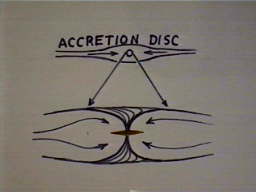ACCRETION PATTERN OF A HIGH SPIN RATE BLACK HOLE, seen actively accreting matter
 In extreme close-up, the infall from the accretion
In extreme close-up, the infall from the accretion
disc is seen to ride "up and over" the final hump
before plunging in through the poles. The poles are the natural pathway INTO (not 'onto') the interior. The centrifugally-repellant equator is the least favorable route of entry.
Further, the higher the spin rate, the more acutely the inflows must align to the polar axis.
THE ACCRETION DYNAMIC OF A HIGH SPIN-RATE BH IS THE MOST EXTREME EXAMPLE OF THE LENSE-THIRRING EFFECT. "FRAME DRAGGING" at this scale is NOT MATTER DRAGGING SPACE, BUT SPACE DRAGGING MATTER.
GRAVITIC BIPOLARITY (or bipolar gravity) is an
essential feature of a high spin-rate BH, when viewed in extreme close-up. The BH has clear-cut 'N' and 'S' gravitic poles, their polarity or 'sign' determined by *direction of spin* of the vortex going in. That is, the 'N' vortex will spin CW going in, while the 'S' vortex spins CCW going in, while the whole ensemble rotates in a unitary direction.
A visual example would be a Seyfert (active nucleus) galaxy.
The proton with its N and S magnetic poles is seen as an exact microscale analog of a (spinning) BH. (See next page)
|
|
| |
|
|
||
| previous page |
|
next page |
|
|
||